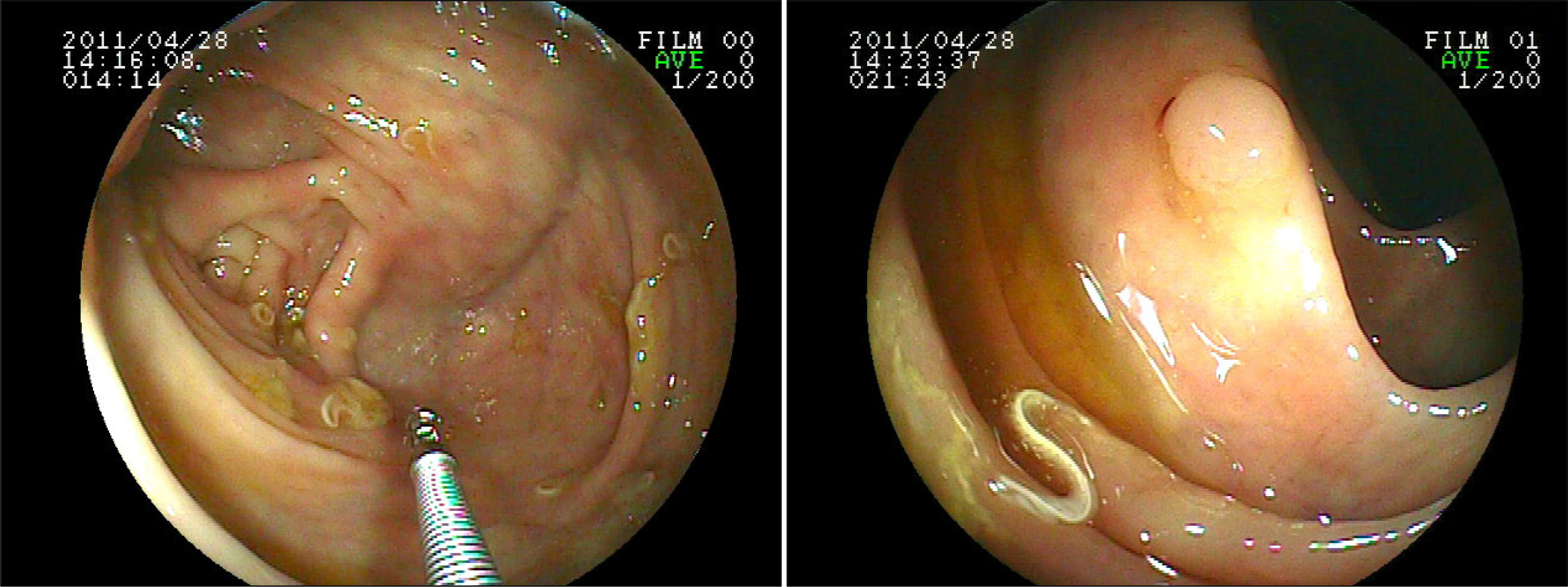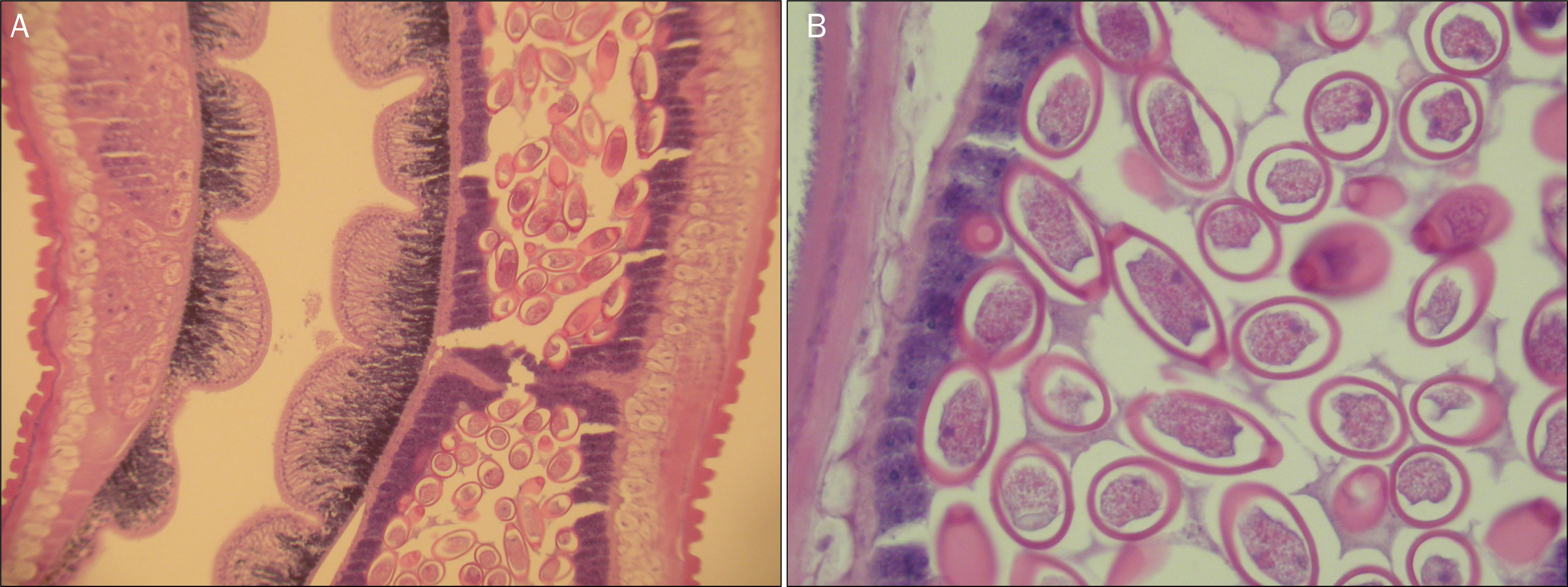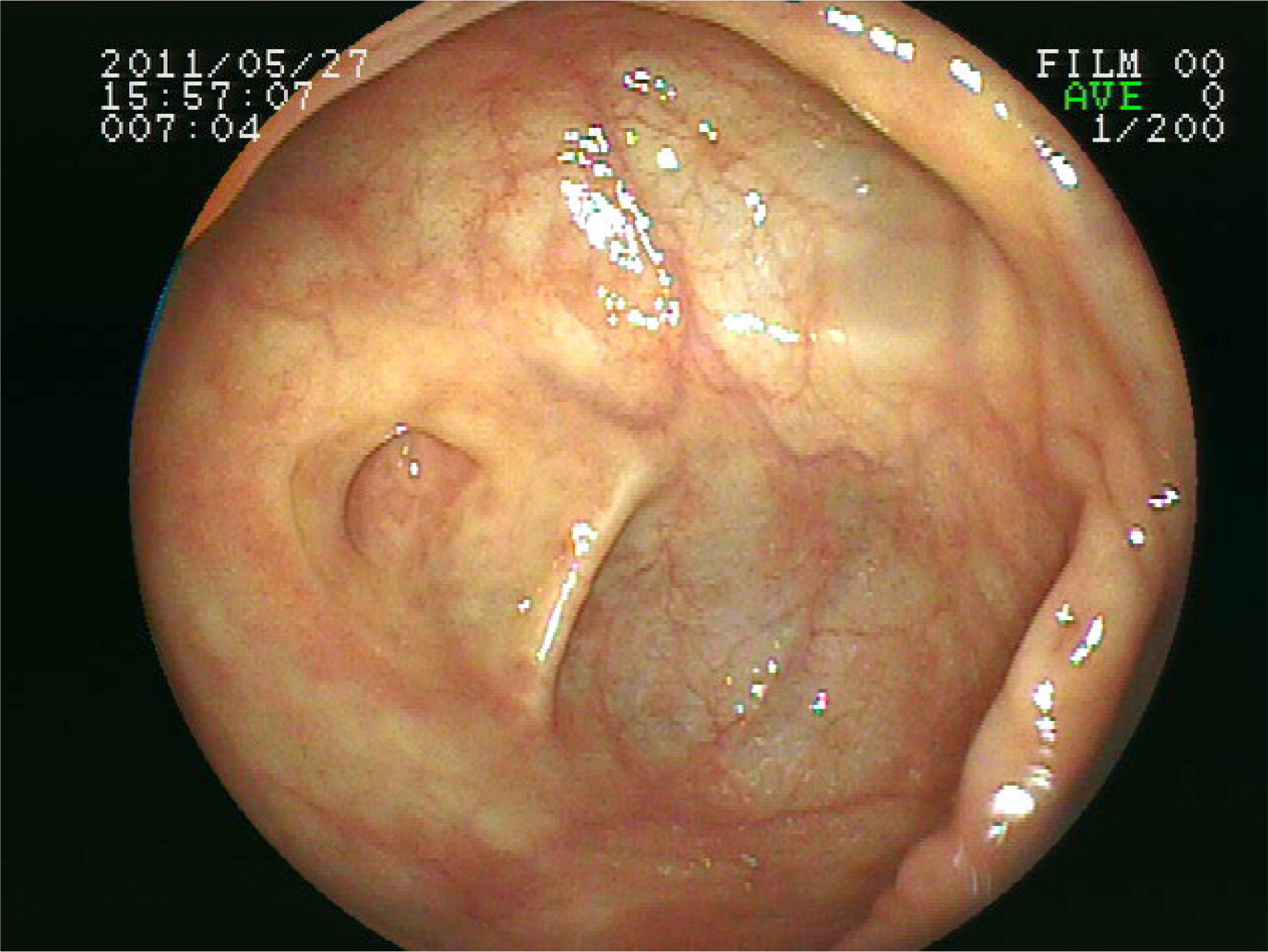Korean J Gastroenterol.
2017 Apr;69(4):243-247. 10.4166/kjg.2017.69.4.243.
Trichuris trichiura Infection in North Korean Defector Resulted in Chronic Abdominal Pain and Growth Retardation
- Affiliations
-
- 1Department of Internal Medicine, Kosin University College of Medicine, Busan, Korea. kisem@naver.com
- KMID: 2383403
- DOI: http://doi.org/10.4166/kjg.2017.69.4.243
Abstract
- Trichuris trichiura infection is a common helminth infection, which is transmitted via soil, with worldwide distribution, especially in rural areas of developing countries. Occasionally, sporadic cases occur in non-endemic, developed areas due to the widespread of immigration. We experienced a case of Trichuris dysentery syndrome in a young North Korean defector, who had been suffering from chronic abdominal pain for 10 years. He is relatively short and thin compared with his older brother. Unexpectedly, the diagnosis, made by a colonoscopy, revealed numerous, small, white, and gently moving worms at the cecum and ascending colon. After 3 days of albendazole (400 mg once daily) administration, clinical symptoms subsided dramatically. On the follow-up colonoscopy, which was performed two months after the completion of his treatment, complete eradication was identified. Soil-transmitted helminths, including Trichuris trichiura, are disappearing becoming less prevalent in South Korea as a result of both national driving force and environmental improvement. However, these diseases should be considered when we meet foreign patients from developing countries, like North Korea, presenting chronic abdominal pain. Moreover, proper treatment of North Korean defectors and performing cohort studies of them would help to prepare for the possible unification era in the field of gastroenterology.
MeSH Terms
Figure
Reference
-
References
1. Hong ST, Chai JY, Choi MH, Huh S, Rim HJ, Lee SH. A successful experience of soil-transmitted helminth control in the Republic of Korea. Korean J Parasitol. 2006; 44:177–185.
Article2. Sahimin N, Lim YA, Ariffin F, Behnke JM, Lewis JW, Mohd Zain SN. Migrant workers in Malaysia: current implications of sociodemographic and environmental characteristics in the transmission of intestinal parasitic infections. PLoS Negl Trop Dis. 2016; 10:e0005110.
Article3. Khuroo MS, Khuroo MS, Khuroo NS. Trichuris dysentery syndrome: a common cause of chronic iron deficiency anemia in adults in an endemic area (with videos). Gastrointest Endosc. 2010; 71:200–204.
Article4. Hotez PJ, Molyneux DH, Fenwick A, et al. Control of neglected tropical diseases. N Engl J Med. 2007; 357:1018–1027.
Article5. Stephenson LS, Holland CV, Cooper ES. The public health significance of trichuris trichiura. Parasitology. 2000; 121(Suppl):S73–S95.
Article6. Fuhrimann S, Winkler MS, Pham-Duc P, et al. Intestinal parasite infections and associated risk factors in communities exposed to wastewater in urban and peri-urban transition zones in Hanoi, Vietnam. Parasit Vectors. 2016; 9:537.
Article7. Ann SY, Ryou SH, Kim SB. Clinical characteristics of defectors from North Korea visiting a single tertiary hospital in South Korea. Korean J Med. 2015; 89:54–63.
Article8. Cooper ES, Bundy DA, MacDonald TT, Golden MH. Growth suppression in the trichuris dysentery syndrome. Eur J Clin Nutr. 1990; 44:285–291.9. Simeon DT, Grantham-McGregor SM. Nutritional deficiencies and children's behaviour and mental development. Nutr Res Rev. 1990; 3:1–24.
Article10. Callender J, Grantham-McGregor S, Walker S, Cooper E. Developmental levels and nutritional status of children with the trichuris dysentery syndrome. Trans R Soc Trop Med Hyg. 1993; 87:528–529.
Article11. Diniz-Santos DR, Jambeiro J, Mascarenhas RR, Silva LR. Massive trichuris trichiura infection as a cause of chronic bloody diarrhea in a child. J Trop Pediatr. 2006; 52:66–68.
Article12. Krishnamurthy S, Samanta D, Yadav S. Trichuris dysentery syndrome with eosinophilic leukemoid reaction mimicking inflammatory bowel disease. J Postgrad Med. 2009; 55:76–77.
Article13. Azira N MS, Zeehaida M. Severe chronic iron deficiency anaemia secondary to Trichuris dysentery syndrome – a case report. Trop Biomed. 2012; 29:626–631.14. Zanwar VG, Pawar SV, Jain SS, Rathi SP, Contractor QQ, Rathi PM. An unusual cause of overt gastrointestinal bleeding in a malnourished child. Trop Doct. 2016; 46:100–102.
Article15. Keiser J, Utzinger J. Efficacy of current drugs against soil-trans-mitted helminth infections: systematic review and metaanalysis. JAMA. 2008; 299:1937–1948.
Article16. KDI review of the North Korean economy. [Internet]. Sejong (KR): Korea Development Institute (KDI);2016 Mar 15. [cited 2016 Mar 15]. Available from:. http://www.kdi.re.kr/kdi_eng/research/research_view.jsp?pub_no=14649.
- Full Text Links
- Actions
-
Cited
- CITED
-
- Close
- Share
- Similar articles
-
- Two Cases of Trichuris Trichiura Infection Diagnosed by Colonoscopy
- Four Cases of Trichuris Trichiura Infection in the Colon
- Infections of Soil-Transmitted Helminth in Refugees from North Korea
- Anthelmintic effects of single doses of fenbendazole and oxantel-pyrantel pamoate to the intestinal nematodes
- Trichuris trichiura Infection Diagnosed by Colonoscopy: Case Reports and Review of Literature




